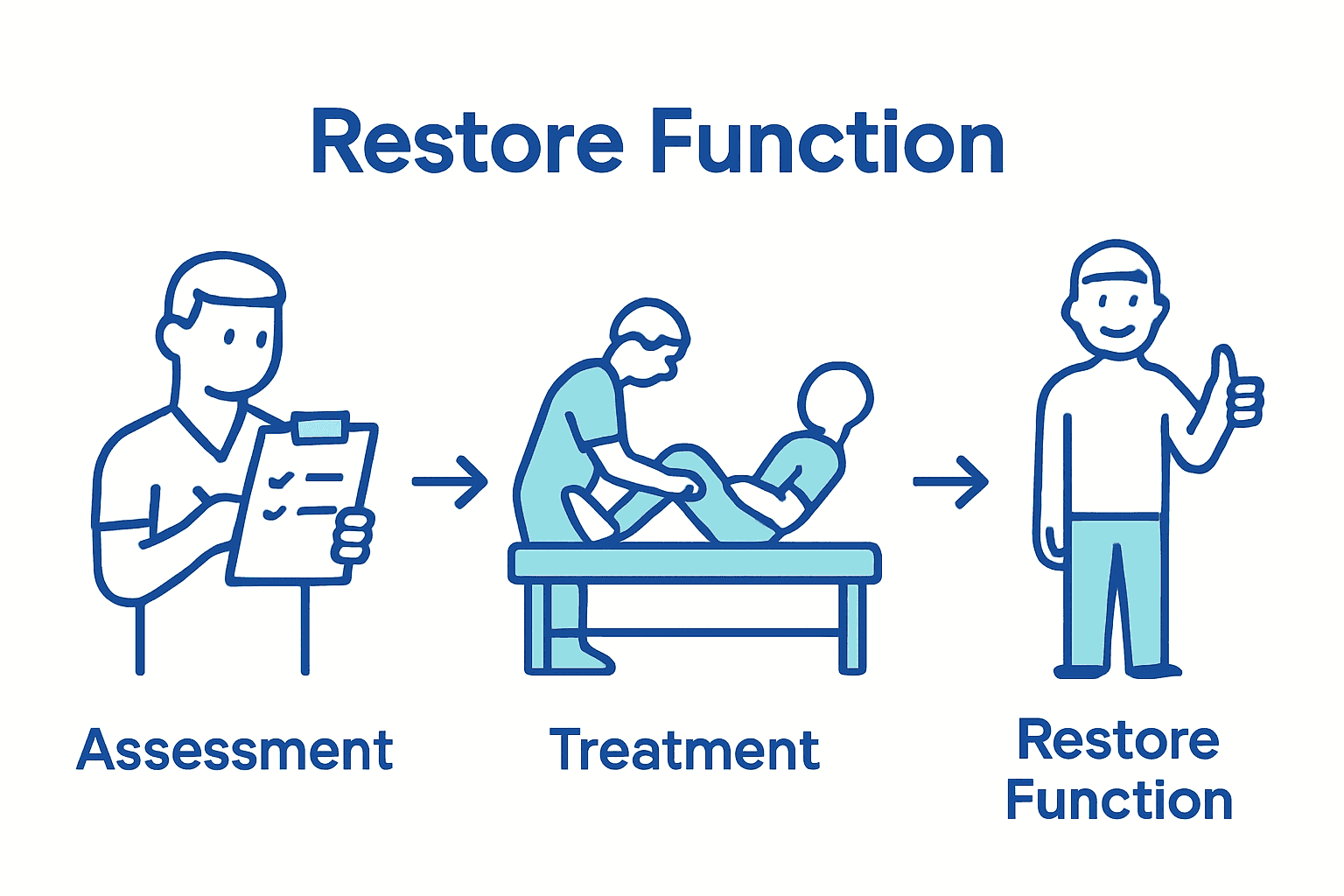Complete Guide to the Role of Physiotherapists
- Nov 6
- 7 min read
Updated: Nov 10

More than four million Canadians benefit from physiotherapy each year, making it a trusted choice for managing pain and improving mobility. Whether you are recovering from an injury, managing a chronic condition, or seeking to enhance your day-to-day movement, physiotherapists play a crucial role in helping people regain strength and independence. Understanding what physiotherapists do and how they tailor treatments can help you make better decisions about your physical health and long-term wellness.
Table of Contents
Key Takeaways
Point | Details |
Role of Physiotherapists | Physiotherapists are crucial in restoring physical function, managing pain, and advocating for overall well-being through personalized treatment plans. |
Types of Treatments | Various physiotherapy specializations address unique patient needs, including orthopedic, neurological, sports, pediatric, and geriatric care. |
Assessment Process | A thorough assessment is vital, involving history review, physical exams, and personalized treatment plan development to ensure effective outcomes. |
Collaboration in Care | Multidisciplinary teamwork enhances patient recovery by integrating insights from various health professionals to provide comprehensive care. |
Defining the Role of Physiotherapists
Physiotherapists are healthcare professionals dedicated to helping individuals restore, maintain, and optimize physical function, mobility, and overall well-being. According to Canadian Institute for Health Information, they are regulated, evidence-based primary healthcare professionals who prevent, assess, and treat the impact of injury, disease, and disorders affecting movement and function.
Their expertise spans multiple domains of human physical performance. Physiotherapists work with patients across various life stages and conditions, from treating sports injuries and managing chronic pain to supporting post-surgical rehabilitation and helping individuals recover from neurological disorders. Physiotherapy at Integrate Ottawa represents a comprehensive approach that addresses not just symptoms, but underlying biomechanical and functional challenges.
Key responsibilities of physiotherapists include:
Conducting detailed physical assessments
Developing personalized treatment plans
Implementing manual therapy techniques
Providing patient education on injury prevention
Designing targeted exercise and rehabilitation programs
Utilizing advanced therapeutic technologies
These healthcare professionals employ a holistic approach, considering each patient’s unique physical condition, lifestyle, and wellness goals. By combining scientific knowledge with hands-on therapeutic techniques, physiotherapists help patients regain strength, improve mobility, manage pain, and ultimately enhance their quality of life.
Common Types of Physiotherapy Treatments
Physiotherapy treatments are diverse and specialized, targeting specific physical conditions and patient needs. At Integrate Ottawa’s Physiotherapy Clinic, patients can access multiple treatment approaches designed to address a wide range of musculoskeletal and neurological challenges.
Some of the most common physiotherapy treatment types include:
Here’s a summary of common types of physiotherapy treatments and their main focus:
Treatment Type | Main Focus | Typical Patient Group |
Orthopedic | Musculoskeletal injuries Joint issues | Post-surgery Active individuals |
Neurological | Nervous system disorders | Stroke survivors MS, Parkinson’s |
Sports Physiotherapy | Athletic injury care Performance | Athletes Active youth |
Pediatric | Developmental & movement challenges | Infants Children |
Geriatric | Age-related mobility & function | Older adults |
Orthopedic Physiotherapy: Focused on treating musculoskeletal injuries, joint problems, and post-surgical rehabilitation
Neurological Physiotherapy: Supporting patients with nervous system disorders like stroke, multiple sclerosis, and Parkinson’s disease
Sports Physiotherapy: Specialized care for athletes, addressing sports-related injuries and performance optimization
Pediatric Physiotherapy: Addressing developmental and movement challenges in children
Geriatric Physiotherapy: Supporting older adults in maintaining mobility and managing age-related physical conditions
Each treatment type employs unique techniques tailored to specific patient requirements. Manual therapy, which includes joint mobilization, soft tissue manipulation, and targeted exercise prescription, forms a core component of most physiotherapy interventions. Advanced treatment approaches at Integrate Ottawa often combine multiple techniques to create comprehensive, personalized rehabilitation strategies.
The goal of these treatments extends beyond immediate pain relief.

Physiotherapists aim to restore function, prevent future injuries, and empower patients with knowledge and techniques to maintain long-term physical health. By understanding each patient’s unique biomechanical patterns and lifestyle factors, physiotherapists develop targeted interventions that promote healing, improve mobility, and enhance overall physical performance.
How Physiotherapists Assess and Treat Patients
The assessment and treatment process is a comprehensive journey that begins with detailed patient evaluation. According to Work Global Canada, physiotherapists systematically assess clients’ physical abilities through evaluative procedures, establish treatment goals, develop and implement treatment plans, and critically evaluate their effectiveness.
The initial assessment typically involves several key components:
Comprehensive medical history review
Detailed physical examination
Range of motion and flexibility testing
Strength and muscle performance evaluation
Postural and biomechanical analysis
Pain assessment and identification of movement limitations
Pelvic Health Physiotherapy at Integrate Ottawa demonstrates how specialized physiotherapists adapt these assessment techniques to specific patient needs. Treatment approaches are never one-size-fits-all but meticulously tailored to individual physical conditions, lifestyle factors, and recovery objectives.
Once the initial assessment is complete, physiotherapists design personalized treatment strategies that may include manual therapy, targeted exercise prescriptions, electrotherapy techniques, and patient education. The ultimate goal extends beyond immediate symptom relief to long-term functional restoration, empowering patients with the knowledge and tools to maintain optimal physical health and prevent future injuries.

Training, Licensing, and Qualifications in Canada
Physiotherapy professionals in Canada undergo rigorous training and credentialing to ensure the highest standards of patient care. According to Physiotherapy Canada, all registered physiotherapists must meet national entry-level education and practice standards and successfully pass a standardized competency examination.
The path to becoming a licensed physiotherapist in Canada typically involves:
Completing a recognized undergraduate or graduate degree in physiotherapy
Passing the National Physiotherapy Competency Examination
Registering with the provincial regulatory body
Maintaining ongoing professional development and continuing education credits
Adhering to strict professional standards and ethical guidelines
Alliance of Physiotherapy Regulators emphasizes that physiotherapists trained outside Canada must complete an additional credentialing process. This includes comprehensive evaluation of their international credentials, potential bridging programs, and mandatory passing of the Physiotherapy Competency Examination to obtain a license to practice.
Beyond initial licensing, Canadian physiotherapists are committed to continuous professional growth. They regularly participate in advanced training, specialized workshops, and research conferences to stay current with the latest treatment techniques and medical advancements. This ongoing commitment ensures that patients receive the most up-to-date, evidence-based care possible, reflecting the dynamic and evolving nature of physiotherapy as a healthcare profession.
Collaboration in Multidisciplinary Care Teams
Multidisciplinary care represents a comprehensive approach to patient treatment that recognizes the interconnected nature of health and healing. At Integrate Ottawa, this collaborative model is exemplified through integrated healthcare strategies that bring together professionals from various disciplines to provide holistic patient care.
Key components of effective multidisciplinary collaboration include:
Shared patient assessment and treatment planning
Regular interdisciplinary communication
Coordinated treatment approaches
Complementary therapeutic interventions
Comprehensive patient progress tracking
Unified goals for patient recovery and wellness
Physiotherapists play a critical role in these collaborative teams, serving as both treatment providers and communication bridges between different healthcare specialists. Their unique expertise in movement, function, and rehabilitation allows them to contribute valuable insights to comprehensive treatment plans, whether working alongside chiropractors, massage therapists, athletic therapists, or medical doctors.
The ultimate benefit of this collaborative approach is enhanced patient outcomes. By combining diverse professional perspectives, patients receive more nuanced, comprehensive care that addresses not just isolated symptoms, but the complex interactions between physical, neurological, and biomechanical systems. This integrated model ensures that each patient’s treatment is thoroughly considered, expertly executed, and continuously refined through ongoing professional dialogue and shared expertise.
Patient Benefits and Common Misconceptions
Physiotherapy offers a range of transformative benefits that extend far beyond traditional pain management. According to Physiotherapy Canada, patients can often access physiotherapy services directly, with many health insurance plans covering treatments without requiring a physician’s referral.
Common misconceptions about physiotherapy include:
It’s only for athletes or people with serious injuries
Physiotherapy is painful and invasive
Results are immediate and permanent
Only works for short-term pain relief
Requires a doctor’s referral for treatment
Expensive and not covered by insurance
Physiotherapy is for Everyone highlights that increasing access to physiotherapy care can significantly alleviate healthcare costs and improve patient outcomes by allowing physiotherapists to work to their full scope of practice. The real benefits of physiotherapy are comprehensive and long-lasting, including:
Improved mobility and physical function
Prevention of future injuries
Personalized rehabilitation strategies
Non-invasive pain management
Enhanced understanding of body mechanics
Holistic approach to overall wellness
By dispelling these myths, patients can better understand physiotherapy as a proactive, patient-centered approach to healthcare that empowers individuals to take control of their physical well-being, prevent potential health issues, and achieve optimal functional performance.
Restore Your Movement and Wellness with Expert Physiotherapy Care
Understanding the vital role physiotherapists play in assessing, treating, and preventing physical challenges is the first step toward reclaiming your quality of life. Whether you struggle with chronic pain, post-surgical recovery, or everyday mobility issues, personalized physiotherapy can help you rebuild strength, improve function, and prevent future injuries. Integrate Ottawa offers a team-based, evidence-supported approach that combines expert assessment with targeted treatments tailored to your unique needs.

Take control of your physical health today by exploring our comprehensive physiotherapy services designed for all ages and conditions. With multiple convenient locations in Ottawa and Carleton Place, and a dedicated team ready to support your journey, now is the time to make your appointment at Integrate Ottawa. Start your personalized rehabilitation plan and experience collaborative care that empowers you to move freely and live fully.
Frequently Asked Questions
What is the main role of physiotherapists?
Physiotherapists are healthcare professionals who restore, maintain, and optimize physical function, mobility, and overall well-being by preventing, assessing, and treating injuries and disorders affecting movement.
What types of treatments do physiotherapists provide?
Physiotherapists provide a range of treatments including orthopedic, neurological, sports, pediatric, and geriatric physiotherapy, tailoring their approach based on the specific needs of each patient.
How do physiotherapists assess their patients?
Physiotherapists conduct a comprehensive evaluation that includes reviewing the medical history, performing a physical examination, testing range of motion and strength, and conducting pain assessments to develop personalized treatment plans.
Do I need a referral to see a physiotherapist?
In many cases, you can access physiotherapy services directly without a physician’s referral; however, this can vary based on specific healthcare plans and regulations.
Recommended

Comments